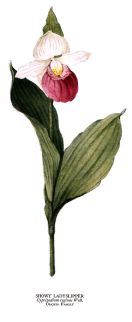Elusive Lady's Slipper
By Audrey Stallsmith

O, men of wisdom, still
A cumbrous name of learned length attach
To this most fragile blossom of the wild.
In heart of me, and verse of mine, it lives,
For aye, a lady slipper, breathing yet
The subtle fragrance of enchanted woods.
"The Lady-Slipper" by Emma Withers
The lady's slipper orchids must remain among the most coveted and elusive of wildflowers. Although there are supposed to be three types native to Pennsylvania, I have never seen any in the wild. But that could mean that I just haven't been in the right place at the right time!
The "showy" type--Cypripedium reginae--does appear on the list of endangered species for Pennsylvania. The other two--moccasin flower (Cypripedium acaule) and yellow lady's slipper (Cypripedium parviflorum) apparently aren't yet threatened enough to qualify.
Cypripedium derives from the Greek Cypris (AKA "Venus" or "Aphrodite") and pedilon ("sandal"). In the Language of Flowers it stands for "capricious beauty," perhaps because--like many beauties--wild orchids can be difficult to please!
The truth is, however, that cypripedium seeds require a certain fungus called rhizoctonia in the soil before they can germinate. There is some debate over whether mature lady slippers also require the fungus. But certain horticulturalists hold that it is as essential as root hairs are to other plants, because it allows the orchids to take up nutrients.
Although slow to flower from seed, lady slippers can endure for at least fifty years or so in a setting they like. So they aren't really capricious--just picky!
But they do find it hard to survive transplantation into a garden setting. Most garden habitats, after all, don't in the least resemble the forests and swamps which the plants prefer. And it was probably the depredations of over-eager gardeners that caused the orchids to become rare in the first place. So please don't try to dig them from the wild. You may be sorry if you do, as lady slippers can cause a skin rash on susceptible individuals!
The largest and most endangered of these three orchids, reginae (being interpreted as "royal"), sports a pink pouch and white petals. If you just want to view or photograph it in its natural setting, one writer recommends looking near deer stomping grounds--or rather wintering grounds. Reginae prefers more light than the other lady slippers, so will often spring up where deer have nibbled or trampled down much of the brush. Look for rotting logs as well, as the showy lady slipper seems to like decaying wood and boggy conditions.
Yellow lady's slipper (Cypripedium parviflorum), with a yellow pouch and brownish petals also likes swampy soil. But, as parviflorum implies, it is a "smaller" flower than the regal one described above.
Cypripedium acaule, AKA moccasin flower, prefers dryer and more acidic conditions--often near trees like tamarack or black spruce. As acaule indicates, this orchid is "stemless." And, unlike the other lady slippers, it has a split in the front of its mauve pouch, and greenish purple petals.
As lady slippers aren't self-pollinating, their pouches are designed to keep insects from leaving the same way they came in. So the buzzers have to exit by a "back door" instead, in the process picking up a fresh supply of pollen to carry to the next plant.
Native American legends about lady slippers usually incorporate a female--either young girl or maiden--who bloodies her feet in the service of others. Whether for running barefoot to the next village in the dead of winter for medicines, or for simply giving her own moccasins to a wounded rabbit, she receives the floral slippers as a reward. You can supposedly even see drops of blood in the yellow lady slipper.
The natives and settlers both employed lady slipper as a tranquilizer to treat any kind of illness connected with "nerves," such as hysteria, delirium, anxiety, depression, headaches, insomnia, and etc. In addition to its shoe-related nicknames, such as squirrel shoes, whippoorwill shoes, etc., it was sometimes known as American valerian. Though lady's slipper bears no actual resemblance to that plant, valerian too is a sedative!
I've read that Emily Dickinson was buried with a lady slipper flower in her coffin, along with wild violets and heliotrope. Those blooms possess a wild charm that would probably put all our modern wired roses and carnations to shame.
Although you can purchase commercially propagated lady slippers from reputable nurserymen, the price of them will probably give you one of those nervous headaches. But, hey, these aren't the type of orchids that just grow on trees!
Cypripedium reginae image is from the National Geographic Society, courtesy of the Southwest School of Botanical Medicine.








